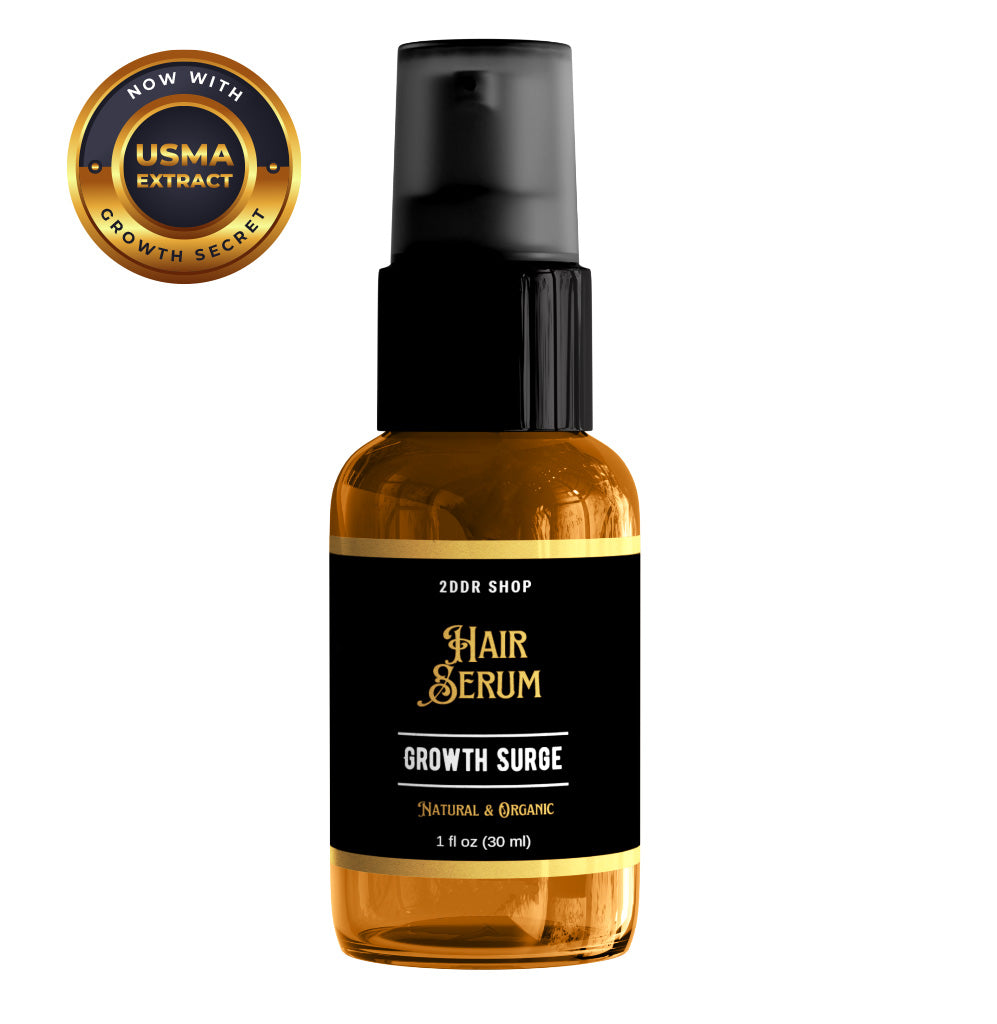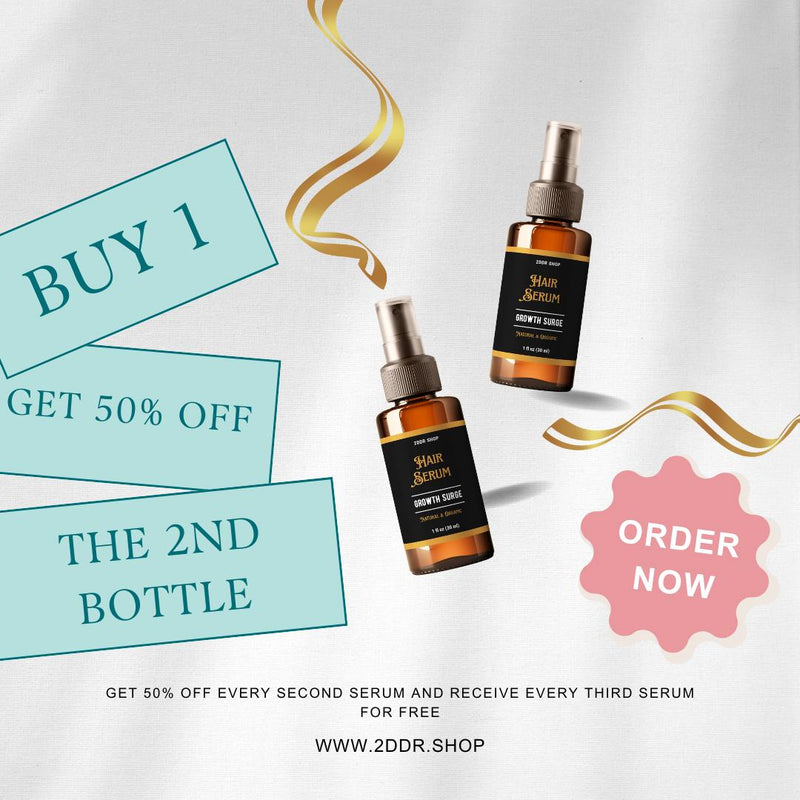Scientific Breakthrough in Combating Hair Loss: 2-Deoxy-D-Ribose (2dDR) for Active Regrowth
Does 2dDR Work As A Hair Loss Treatment?
Only one paper has provided some evidence that 2dDR might improve hair loss outcomes so far. As mentioned above, A research team comprising experts from the University of Sheffield and COMSATS University Pakistan conducted a study to evaluate the effectiveness of 2dDR in addressing hair loss. They carried out their experiments using a mouse model specifically designed to exhibit testosterone-induced hair loss.[15]
The researchers used seven-week-old male C57BL/6 mice that had acclimated to the lab environment before the experiment began. Six groups of mice were created: normal control (no treatment, no testosterone), T-1 model (no treatment, with testosterone), T-2 blank SA (blank hydrogel), 2dDR gel, 2% minoxidil spray (positive control), a combination of minoxidil and 2dDR. Three times per week for two weeks, testosterone was injected. The hair from the backs of the mice was then removed using a hair removal cream and the treatments were applied topically to the areas without hair at a dose of 0.5 mL.
Over the 21-day study, the researchers analyzed several parameters including:
• Hair growth
• Hair shaft diameter
• Hair length
• Anagen/telogen ratio
• The amount of melanin in the hair bulb and the number of blood vessels
• Hair follicle density
• Diameter of hair bulb
To measure hair growth, the researchers determined the mice’s skin color throughout the study. Mice's skin darkens when hair follicles shift from resting to active growth. The mouse’s thin skin makes this color change visible, especially after hair loss. It is this darker skin, which is due to increased melanin production and blood flow associated with active hair growth.[16] Subjectively looking at the mouse photos (Figure 3), it seems that the 2dDR group (T-3 in the figure) had better hair growth than the testosterone (T-1) and hydrogel (T-2) groups. Additionally, the combination group had better hair regrowth in the minoxidil and 2dDR groups.
Figure 3:
(A) Illustration of the experiment outline.
(B) Dorsal hair regeneration in mice was evaluated under various treatment conditions: NC (no treatment), T-1 (testosterone), T-2 (blank hydrogel), T-3 (2dDR), T-4 (minoxidil), and T-5 (combined 2dDR and minoxidil). Observations were recorded at intervals of 0, 7, 14, and 21 days.
(C) Mouse skin color score index.
(D) Graphical representation depicting skin color scores across different treatment groups measured on days 0, 4, 8, 12, 16 and 20. *** p≤0.001, **p<0.01, and ns p>0.05.[17]
The researchers then looked at hair shaft length and hair shaft diameter. Hair length was improved to the same level as the untreated control (NC) and increased compared to the testosterone-only treated group in all three treated groups (2dDR, minoxidil, and combination minoxidil). The 2dDR and minoxidil groups were also at a similar level to the NC group and better than the testosterone-only treated group in hair shaft diameter (Figure 4).

Figure 4: Analysis of hair length and shaft diameter.
(A) Digital photographs of hair length.
(B) Analysis of hair length from skin sections. ****p≤0.0001, *** p≤0.001, **p<0.01, and ns p>0.05. Sixty hairs were taken from 3 mice of each group. Each group was compared to the NC group (untreated control).[18]
Even over the NC group, the 2dDR and minoxidil-treated groups were improved regarding hair follicle length. The longer the hair follicle is, the deeper it will be in the scalp. The more likely the hair follicle is in the scalp, the deeper it is in the scalp, the more likely it is to be in anagen.[19] Skin sections were taken on day 21 and hair follicle density was also measured. All three treated groups (2dDR, minoxidil, and combination) were significantly improved compared to the NC group (Figure 5). However, it should be noted that there was no mention of trying to reduce bias here. But how do we know that they didn’t take sections of skin with more hair present in the treated groups and not in the untreated groups? This would be unconscious bias, and in these cases, it would be better to mark an area before treatment in the same place on each mouse so that a more unbiased approach can be taken. In Figure 3, if you look back, we would say that most of the mice in T-3 did not reach the level of regrowth as the NC group, but in Figure 5, the hair follicle density is significantly higher. Things like this need to be considered when doing hair growth studies because these could cast a shadow of doubt over an otherwise well-intentioned study.

Figure 5:
(A) Microscopic analysis of skin sections for hair follicle length on day 21.
(B) Comparison of hair follicle length over the treatment groups.
(C) Hair follicle density in skin sections examined through microscopic analysis
(D) Comparison of hair follicle density over the treatment groups. Each group was compared to the NC group (untreated control). ****p≤0.0001, *** p≤0.001, **p<0.01, and ns p>0.05.[20]
The subsequent phase of the study involved analyzing the diameter of the hair bulb and the anagen/telogen ratio in skin sections. Mice treated with 2dDR had the largest hair bulb diameter, comparable to the untreated hair follicles (Figure 6). All of the treated hair follicles (2dDR, minoxidil, and combination) had significantly higher ratios of anagen/telogen hairs than the untreated mice.

Figure 6:
(A) Microscopic analysis of skin sections for bulb diameter analysis on day 21.
(B) Comparison of hair bulb diameters over the treatment groups.
(C) Microscopic analysis of skin sections for anagen/telogen ratio analysis on day 21.
(D) Comparison of anagen/telogen ratios over the treatment groups. Each group was compared to the NC group (untreated control). ****p≤0.0001, *** p≤0.001, **p<0.01, and ns p>0.05.[21]
The researchers subsequently examined the melanin coverage in the hair bulb area and the number of blood vessels in the skin sections. The 2dDR-treated mice showed similar results to the untreated hair follicles in both cases (Figure 7), indicating that the product was able to induce the anagen stage.

Figure 7:
(A) Microscopic analysis of skin sections for bulb diameter analysis on day 21.
(B) Comparison of hair bulb diameters over the treatment groups.
(C) Microscopic analysis of skin sections for anagen/telogen ratio analysis on day 21.
(D) Comparison of anagen/telogen ratios over the treatment groups. Each group was compared to the NC group (untreated control). ****p≤0.0001, *** p≤0.001, **p<0.01, and ns p>0.05.[22]
Interestingly, for most of these results, 2dDR alone seemed to outperform minoxidil and a combination of minoxidil and 2dDR, suggesting that it may not have an additional benefit as a complementary treatment.
How should we interpret this Mouse Study On 2dDR Mean?
To appear positively from the first sight, is then, the results are. But there are some limitations:
1.This study was conducted in mice.
Mouse models are fantastic for first investigating a product, but are often not a 1:1 representation of what the product will do in human beings, specifically as the mouse hair cycle is not the same as a human derivative. It is therefore difficult to conclude whether the 2dDR is effective. In addition, mouse models, even when the mice are genetically bred to resemble “androgenic alopecia” mice, have very poor translatability to humans with androgenic alopecia. Hair loss in humans is still too polygenic to be adequately captured and translated into mice, and vice versa.[23]
2.The study does not specifically mention whether the skin sections were taken from the same area of the mouse for each treatment group.
Unfortunately, this leaves the study open to unconscious bias, as the researchers may have unconsciously selected sections from more 'hairy' areas of the skin in the treated groups. We struggled to see how the 2dDR group (T-3) outperformed the untreated group (NC) so well just by looking at the mouse images.
In other words, 2dDR seemed to work as well or better than minoxidil in most cases in mice. Is this enough evidence for humans to use it?
Should I Use 2dDR For Hair Growth?
At present, there is no long (or short) term safety or efficacy evidence to support 2dDR’s use in humans for hair regrowth.
Then perhaps you should consider this product if you are ok with this.
• You are comfortable experimenting with a product that has no clear data on clinical efficacy or safety.
• You want to try 2dDR in addition to better-supported hair loss treatments, or you’ve tried better-supported treatments in the past and can’t tolerate them or didn’t benefit from them.
• You’re an early user of new hair loss treatments.
• You are ready to use a product three times a day.
2dDR Hair Serum: The Future of Hair Restoration
Based on the promising research on 2-deoxy D-ribose (2dDR) as a hair growth stimulant and the extra information, our 2dDR Hair Serum made its way into creation. This advanced formula is an outstanding product designed to fight hair loss and ease natural regrowth of hair designed to combat hair loss and provide thicker, fuller hair.
How 2-Deoxy-D-Ribose (2dDR) Works to Promote Hair Regrowth
The key ingredient for revolutionizing 2-deoxy-D-ribose hair growth is therefore 2dDR — 2-Deoxy-D-Ribose, a fundamental sugar molecule in cellular energy production. It is necessary for the formation of ATP (adenosine triphosphate), the molecule of the energetics of cells. When applied to the scalp, 2dDR stimulates the activity of hair follicles and promotes hair growth by improving energy metabolism in the hair follicles.
Boosts Follicle Activity: Using 2dDR hair serum helps increase the levels of ATP that awaken dormant hair follicles that then create new, healthy hair strands.
Strengthens Existing Hair: 2dDR also stimulates new growth, but what’s more, it is strengthening current hair making it harder to damage and less breakable.
Supports Scalp Health: A healthy scalp can’t help healthy hair. 2dDR promotes good circulation and feeds the scalp to provide the best environment for hair growth.
Why Choose Our 2dDR Hair Growth Serum?
Our 2dDR hair growth serum packs the punch of 2 deoxy D ribose and other known amounts of hair growth agents for a hardware approach to hair loss. Our serum is suitable for whatever stage you have come to in terms of hair thinning or hair loss because we target the root cause and stimulate the growth of your hair.
Clinically Backed Formula: A study of 2dDR in favor of its possible positive effects on cellular energy and stimulation of hair follicles has made it a promising ingredient against hair loss.
Lightweight and Non-Greasy: It is ideal for application every day as it is easy to apply, absorbs quickly, and does not leave a greasy residue.
Safe for All Hair Types: Irrespective of fine, thick, straight, or curly hair, our 2dDR hair serum is made to work well on all kinds of hair.
How to Use the 2dDR Hair Serum
The 2dDR serum is designed to get the best results when applied to the scalp once daily to places of thinning or hair loss. It should be a light massage to make sure it is even and to stimulate the blood flow to the scalp. Hair density and thickness will improve most with use over several months.
Real Results from Real Users
Promising results have been shown from our first trials, users are seeing positive results with hair density and hair strength showed just a few months of use. Although individual results will vary, the continual use of 2-deoxyD-ribose hair serum gives notice that this product does what it is supposed to do; it encourages hair regrowth.
No time to waste to take care of your hair health. 2-Deoxy-D-ribose is a transformative product capable of providing you with thicker and fuller hair.
Get your 2dDR Hair Growth Serum now and see the difference yourself!


